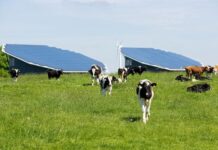by Drew Spoelstra, President, OFA
Every year, Earth Day draws our collective attention to environmental issues – which is exactly what it was designed to do when it was first launched in the United States more than 50 years ago.
Climate change has also been sharpening the world’s focus on the environment, resulting in growing demand for greater environmental sustainability and new government policies around everything from taxation and emissions targets to phasing out the use of products like plastics.
None of this is new to farmers, however. We’ve always had to work with the environment to be successful and create businesses that are both environmentally and financially sustainable, and we know the importance of healthy soils, fresh air and clean sources of water.
Stewardship of the land is a responsibility that we take seriously, and Ontario farmers have long been implementing practices that can mitigate our impact on the environment. These include reducing tillage and soil erosion, protecting wetlands and watersheds, planting trees, and responsible management of nutrients like manure and fertilizer, for example.
The climate impacts everything we do as we raise livestock and grow crops, from extreme weather events and soaring temperatures and droughts to new crop diseases and pests that couldn’t previously thrive here.
Depending on where someone farms or what kind of crops they grow, they will need different practices to be productive and sustainable, but there are many different ways to put environmental sustainability into practice on the farm.
My family and I farm near Hamilton, where we milk cows, pasture beef cattle, grow crops and raise Clydesdales. For decades, we’ve been making changes that make our farm more sustainable and support soil health and we continue to do so on an ongoing basis.
Much of what we do focuses on preserving and boosting the health of our soils – healthy and productive farmland is a fundamental building block of food production and the future of farming in Ontario. We’ve installed tiled drainage in some of our fields to help the land better manage water, we grow cover crops to improve soil quality, nutrient uptake and water filtration and we limit activities that cause soil compaction so that we can create a better soil structure.
We also make sure that we test our soils regularly and manage our nutrients properly, following the 4R stewardship program of placing the right nutrients at the right rate in the right place at the right time to minimize their impacts on air and water.
And like most farmers, we are always making investments and improvements to equipment so that we have precise control over where and how we spread manure, fertilizer or spray plant protection products, for example.
That’s why we believe it’s very important for government and other policymakers to take a close look at the positive environmental changes that have already been happening in agriculture for the last 20 years or more, and take those into account when they’re developing new programming or requirements around sustainability and climate change mitigation. Not everything requires action above and beyond what is already normal farm practice.
At the same time, building environmental sustainability and resilience is a collective responsibility and farmers can’t do it alone. Many of these activities also come with broader public and societal benefits, and we will need technical and financial support if we are to remain competitive in a global marketplace and make investments into new technologies.
We also need a streamlined regulatory environment with greater collaboration between all levels of government so that their policies and legislation aren’t contradicting each other or creating unintended consequences for farm businesses that limit our ability to produce food. A key part of that is ensuring that we preserve our farmland and prioritize it for agricultural production. Ensuring that governments at every level implement policy that allows farm businesses to thrive and grow has never been more critical.
And finally, consumers can show their support too by buying local, going to farmers’ markets and learning about what we’re doing right here at home to improve the sustainability of our local food system.


